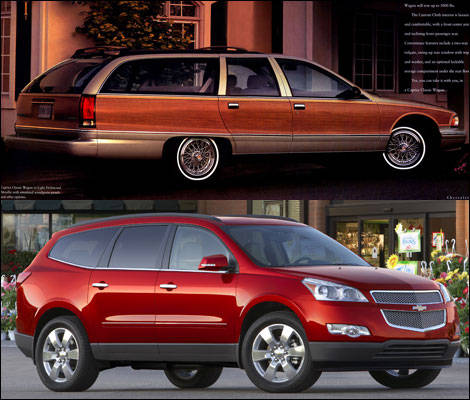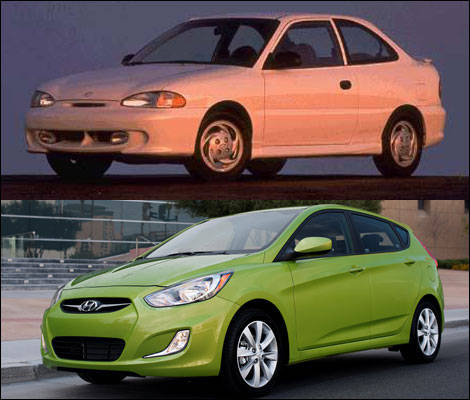The engines in new cars and trucks are getting smaller. They’re smaller in displacement, but produce as much power as the bigger engines they’ve been summoned to replace, while providing greater fuel economy – in theory.
When you compare the fuel economy of today’s vehicles to the ones on the market 15 years ago, however, you’d be surprised at how little improvement has been made to today’s combustion engines. And in some cases, there isn’t an improvement at all.
What some examples? Here we go.
The 1995 Chevrolet Caprice Wagon was powered by a 5.7L V8 engine – the LT1 – which produced 260 hp. Back then, the Caprice‘s fuel consumption was rated at 14.0L/100km city and 8.6L/100km highway.
Today, a vehicle as spacious as the Caprice Wagon in Chevy’s lineup is the Traverse crossover, equipped with a 288-hp, 3.6L V6. A smaller engine and 15 years of engine technology progress would logically make the Traverse much more fuel-efficient, n’est-ce pas? The front-drive Traverse’s fuel consumption is rated at 12.7L/100km city and 8.4L/100km highway.
How about a Tahoe? It’s got a 5.3L V8 that produces 320 horsepower and is blessed with Active Fuel Management, which shuts off half its cylinders under light loads in order to save fuel. The RWD Tahoe’s ratings are 14.3L/100km city and 9.4L/100km highway. That’s actually worse than the 17-year-old Caprice with its detuned Corvette engine.
Ok, but what about small cars?
The 1995 Toyota Corolla was equipped with a 1.8L inline-4 that produced 105 hp and consumed fuel at a rate of 8.1L/100km city and 6.4L/100km highway. Today’s Corolla is still equipped with a 1.8L engine but benefits from 132 horsepower. Fuel economy ratings: 7.4 and 5.6 L/100km city/highway, which amounts to a combined improvement of 10%. Whoopee.
What is arguably the most fuel efficient subcompact on the market today, the 2012 Hyundai Accent, provides fuel economy figures of 6.7/4.9 L/100km city/highway, thanks to its 138-hp, 1.6L inline-4. Back in 1995, the Accent was equipped with a 92-hp, 1.5L four which boasted ratings of 8.0L/100km city and 5.7L/100km highway. That’s a combined improvement of 15%, which doesn’t seem like much when you consider that horsepower climbed by 50%.
Bottom line: manufacturers are marketing their new vehicles as being more fuel efficient, but in reality, they aren’t all that much more. Better equipped? Yes. Safer? Sure. More powerful? Absolutely. More fuel efficient? Hardly.
Then again, car manufacturers aren’t stupid; they’re building cars people want to buy (with exceptions) based on customer feedback, focus groups and what the competition is doing.
What that means: the buying public is asking for better-equipped and more powerful cars and trucks, while maximum fuel economy is but a small concern.
All of a sudden, that 1995 Caprice Wagon is starting to look good.
When you compare the fuel economy of today’s vehicles to the ones on the market 15 years ago, however, you’d be surprised at how little improvement has been made to today’s combustion engines. And in some cases, there isn’t an improvement at all.
What some examples? Here we go.
The 1995 Chevrolet Caprice Wagon was powered by a 5.7L V8 engine – the LT1 – which produced 260 hp. Back then, the Caprice‘s fuel consumption was rated at 14.0L/100km city and 8.6L/100km highway.
 |
| 1995 Chevrolet Caprice Wagon and 2012 Chevrolet Traverse (Photos: General Motors) |
Today, a vehicle as spacious as the Caprice Wagon in Chevy’s lineup is the Traverse crossover, equipped with a 288-hp, 3.6L V6. A smaller engine and 15 years of engine technology progress would logically make the Traverse much more fuel-efficient, n’est-ce pas? The front-drive Traverse’s fuel consumption is rated at 12.7L/100km city and 8.4L/100km highway.
How about a Tahoe? It’s got a 5.3L V8 that produces 320 horsepower and is blessed with Active Fuel Management, which shuts off half its cylinders under light loads in order to save fuel. The RWD Tahoe’s ratings are 14.3L/100km city and 9.4L/100km highway. That’s actually worse than the 17-year-old Caprice with its detuned Corvette engine.
Ok, but what about small cars?
The 1995 Toyota Corolla was equipped with a 1.8L inline-4 that produced 105 hp and consumed fuel at a rate of 8.1L/100km city and 6.4L/100km highway. Today’s Corolla is still equipped with a 1.8L engine but benefits from 132 horsepower. Fuel economy ratings: 7.4 and 5.6 L/100km city/highway, which amounts to a combined improvement of 10%. Whoopee.
What is arguably the most fuel efficient subcompact on the market today, the 2012 Hyundai Accent, provides fuel economy figures of 6.7/4.9 L/100km city/highway, thanks to its 138-hp, 1.6L inline-4. Back in 1995, the Accent was equipped with a 92-hp, 1.5L four which boasted ratings of 8.0L/100km city and 5.7L/100km highway. That’s a combined improvement of 15%, which doesn’t seem like much when you consider that horsepower climbed by 50%.
 |
| 1995 Hyundai Accent and 2012 Hyundai Accent (Photos: Hyundai) |
Bottom line: manufacturers are marketing their new vehicles as being more fuel efficient, but in reality, they aren’t all that much more. Better equipped? Yes. Safer? Sure. More powerful? Absolutely. More fuel efficient? Hardly.
Then again, car manufacturers aren’t stupid; they’re building cars people want to buy (with exceptions) based on customer feedback, focus groups and what the competition is doing.
What that means: the buying public is asking for better-equipped and more powerful cars and trucks, while maximum fuel economy is but a small concern.
All of a sudden, that 1995 Caprice Wagon is starting to look good.


